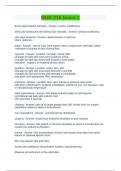NUR 216 Exam 2
Brown pigmentation indicates - Answer- venous insufficiency
Shiny and translucent skin without hair indicates - Answer- arterial insufficiency
skin tugor locations - Answer- adults-forearm or sternum
infant- abdomen
pallor - Answer- -loss of color: best noted in face, conjunctivae, nail beds, palms
-indication of anemia or lack of blood flow
cyanosis - Answer- Location- nail beds, sclera, MM
Changes for light skin tones best located in sclera
Changes for dark skin tones best located in hard palate
indication - hypoxia, or imapired venous return
jaundice - Answer- Location- sclera, skin, MM
Changes for light skin tones best detected in oral MM
Changes for dark skin tones best detected in hard palate
Indication- liver dysfunction, RBC destruction
erythema - Answer- Location- face, skin, trauma or pressure sore areas
Indication- inflammation, localized vasodilation, substance use, sun exposure, rash
or elevated body temperature
Nails expectations - Answer- firm bases and nail angles of 160 degrees
symmetrical nail beds with uniform color
CRT less than 3 seconds
clubbing - Answer- nails at an angle greater than 160, results from low oxygen
saturations related to heart or lung disease
hair expectations - Answer- symmetrical hair distribution
alopecia - Answer- results from endocrine disorders or poor nutrition
hirsutism - Answer- hair growth on the face shoulders or chest of a female that can
results from endocrine disorders
edema - Answer- The accumulation of fluid in the tissues most often from direct
trauma or imparied venous return
Skin may appear tight and shiny
Assess the swelling for discoloration, location, and tenderness
Measure circumference in the extremities
, Evaluate pity by compressing the skin for at least 5 seconds over a bony
prominence, the dept reflects the degree of edema
edema rating - Answer- 1+ trace, 2mm, rapid term
2+ mild, 4mm, 10-15 sec return
3+ moderate, 6mm, prolonged return
4+ severe, 8mm, prolonged term
primary lesions arise - Answer- from healthy skin tissue
macule - Answer- Nonpalpable, skin color change, smaller than 1cm
Freckle, petechiae
papule - Answer- Palpable, circumscribed, soiled elevation of the skin
Elevated nevus
nodule - Answer- Palpable, circumscribed, deep, dirm 1 to 2 CM
Wart
vesicle - Answer- Serous fluid filled smaller than 1 cm
Blister, herpes simplex, varicella
pustule - Answer- Pus filled, varies in size
Acne
tumor - Answer- Solid mass, deep, larger than 1 to 2 cm
Epithelioma
wheal - Answer- Palpable, irregular border, edematous
Insect bite
secondary lesions result from - Answer- a change in primary lesions
erosion - Answer- Loss of epidermis, moist surface, no bleeding
Ruptured vesicle
crust - Answer- Dried blood, serum or pus
Scab
scale - Answer- Flakes of skin that exfoliate
Dandruff, psoriasis, eczema
fissure - Answer- Linear crack
Tinea pedia
ulcer - Answer- Loss of epidermis and dermis with possible bleeding, scarring
Venous stasis ulcer, pressure, ulcer




